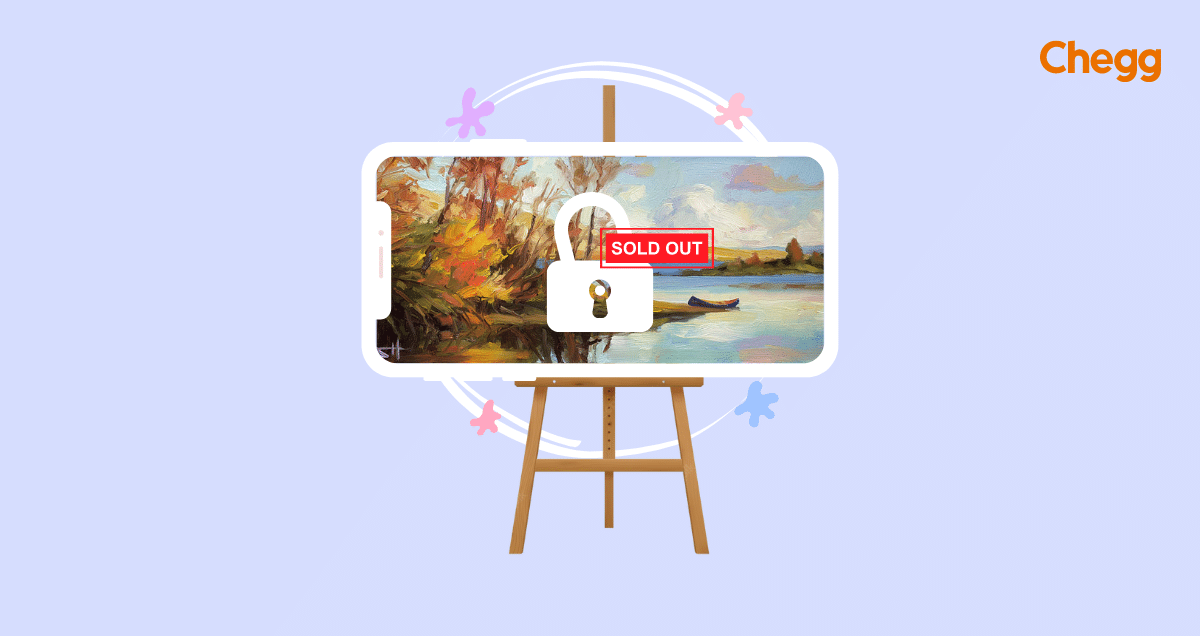Home » Earn Online » Unlocking the Digital Canvas: How to Sell Paintings Online
Unlocking the Digital Canvas: How to Sell Paintings Online

Table of Contents
Selling paintings online is a great way for artists to make money. It’s a good opportunity because there are lots of people who buy art online.
There are many benefits to selling art online. For one, artists can reach a bigger audience than they could in a traditional gallery. This means more people will see their work and potentially buy it.
Also, artists don’t have to pay as much in fees and commissions when selling online, which means they get to keep more of the money from their sales.
If you are wondering how to sell drawings online, you are at the right place. The online art market is growing quickly. More and more people are buying art online, which means there are more opportunities for artists to sell their work.
There are many online platforms that artists can use to sell their art, such as Etsy, Saatchi Art, and Art Finder. These platforms make it easy for artists to showcase their work and reach potential buyers all over the world.
Steps to Sell Your Art Online
Step 1: Create an Online Presence
The first step to selling art online is to establish a digital presence. Many types of websites are available to artists, each with pros and cons. You could create your website or online gallery, use an existing art marketplace like Etsy or Saatchi Art, or even sell your art on social media platforms like Instagram or Facebook.
When creating an online gallery or website, it’s important to choose a domain name that’s easy to remember and reflects your brand or style. You’ll also need to select a hosting provider like Amazon and design a layout that showcases your art in the best possible way.
Think about how you can make your website or gallery visually appealing, easy to navigate, and informative for potential buyers and eventually how to sell paintings online.
Step 2: Take Great Photos and Write Compelling Descriptions
Once you’ve created your online presence, it is time to think about how to sell paintings online. Start with showcasing your art.
Taking good pictures of your art is essential to attracting potential buyers. Make sure to use natural light, avoid reflections and shadows, and crop the image to highlight the most important features of your art.
It is also crucial to write compelling descriptions of your art that provide details about the medium, size, and inspiration behind each piece. This will help buyers understand the unique story behind each piece and connect with it on a deeper level.
Step 3: Price Your Artwork
Pricing your artwork can be challenging, but it’s important to strike a balance between what’s fair to you and what’s reasonable for potential buyers. Consider using a formula that accounts for the cost of materials, time, and overhead, and the market demand for your style and genre of art.
You could also experiment with different pricing strategies, such as offering limited editions, discounts for multiple purchases, or seasonal promotions, you can read this guide on how to sell paintings online on Flipkart.
Step 4: Build and Maintain Relationships with Buyers
Building strong relationships with buyers is essential to selling paintings online successfully. Take the time to send personalized thank-you notes and offer special perks or incentives for repeat customers.
Additionally, respond promptly and courteously to any questions or concerns they may have. Treating your buyers like valued customers and friends will create a loyal following and increase the chances of repeat business.
Step 5: Maximize Your Online Art Sales
To understand how to sell paintings online, it’s important to experiment with different marketing channels and strategies to see what works best for your specific audience. Collaborating with other artists or art organizations to cross-promote each other’s work is a good strategy for expanding the audience base.
Similarly, using data analytics tools to track customer behaviour and preferences and experimenting with different marketing channels can help you reach a wider audience and increase sales.
By following these five steps and supplementing them with additional tips and case studies, you can create a successful online art business that showcases your unique style.
Remember to be patient, and persistent, and always put your art and customers first. You can turn your passion for art into a thriving online business with dedication and hard work.

Handling Challenges and Risks
Protecting Your Artwork from Copyright Infringement
As an artist, you must take steps to protect your artwork from copyright infringement while figuring out how to sell paintings online. One way to do this is by registering your artwork with the copyright office to secure legal ownership and rights. For example, in the US you can register artwork with the United States Copyright Office.
Another way is to add a watermark or signature to your work to deter potential theft. You can use tools like Adobe Photoshop or Lightroom to add your signature to your artwork. Additionally, using digital tools to track and monitor unauthorized use of your art can help you identify infringers.
If you discover someone using your artwork without permission, you can consider hiring a lawyer to send a cease and desist letter or file a lawsuit against infringers. Finally, it is essential to familiarize yourself with fair use and public domain laws to ensure you are not infringing on others’ copyrights.
Dealing with Online Payment and Transaction Issues
Selling artwork online involves dealing with various payment and transaction issues. To ensure secure transactions, it is essential to use a trusted payment gateway such as PayPal, Stripe, or Square.
Additionally, providing clear payment and refund policies can help avoid customer confusion and disputes. Be aware of any transaction fees or charges that may affect your profits, and keep track of all transactions and financial records for accounting and tax purposes.
You can also consider using escrow services for high-value transactions or with unfamiliar buyers to minimize the risk of fraud.
Managing Art Commissions, Custom Orders, and Returns
Taking commissions and custom orders is an excellent way to expand your customer base and earn more money. However, it’s essential to establish clear terms and conditions for commissions and custom orders. These include setting clear timelines, pricing, and revisions.
Getting written agreements or contracts with clients can help avoid misunderstandings or disputes. In case of returns, you should have a clear policy, including any fees or conditions.
It’s also important to communicate regularly with clients throughout the commission process to ensure their satisfaction. Keeping detailed records of commissions and custom orders can help you provide better customer service and use them for future reference or marketing purposes.
Handling Customer Complaints and Disputes
No matter how hard you try, you may encounter customer complaints or disputes. Responding promptly and professionally to customer complaints or issues is essential for maintaining good customer relations.
Listen to their concerns and offer solutions or compromises when appropriate. Have a clear policy for handling disputes, including any escalation procedures or third-party mediation options. Document all communication and steps taken to resolve the issue. Finally, use negative feedback as an opportunity to improve and learn from the experience.
Also Read: From Clutter to Cash: How to Sell Books Online Successfully
Selling Paintings Online Made Easier
Choosing how to Sell paintings online can be confusing for artists to showcase their talent and reach a wider audience. If you’re an artist looking to sell paintings online, there are a few steps you need to follow to set yourself up for success.
Firstly, you need to establish an online presence. You can do this by creating your website or using online marketplaces such as Etsy, Saatchi Art, or Art Finder. These websites allow you to showcase your paintings to buyers from all over the world.
It is important to create high-quality images and detailed descriptions of your artwork. This will help attract potential buyers and give them a better insight into your art. Ensure your pictures are detailed and the descriptions are clear and informative.
When pricing your artwork, it is important to consider the cost of materials, time, and commission fees to ensure profits. Pricing plays a crucial role in setting a user base and hence, must be done mindfully.
You can also offer different options to make your art more affordable, such as offering prints or smaller versions of your paintings. This can help attract a wider range of buyers who may not be able to afford your original pieces.
Promoting your artwork is also crucial for success. You can do this through social media, email marketing, and advertising. These strategies can help increase visibility and attract potential buyers to your online store.
How to Sell paintings online can be a tricky question, just like any other business. You need to ensure no one steals your art, handles payments, and deals with customer issues like complaints and returns.
It is important to know these challenges and have a plan to handle them. If you work hard and keep improving your art and interacting with buyers, you can make money selling art online. Just be patient and willing to try new things!
Want to earn money in the comfort of your home? Dive into our guide to Online Jobs.
Frequently Asked Questions (FAQs)
Artists can sell their paintings online to reach more people and build a global audience. This is because an online presence helps increase visibility and gives access to potential buyers worldwide.
Selling art online has lower costs, allows artists to control pricing and distribution, and helps build a following of fans and collectors. Marking an online presence can also help you build your brand that you can leverage for various other projects and work.
When choosing an online platform to sell your paintings, consider factors such as audience reach, user-friendliness, fees, and marketing support. Look for platforms that cater specifically to artists, provide secure transactions, offer customizable galleries, and have positive reviews from other artists. Take your time to compare options and select one that aligns with your goals and needs.
To market art online, create a strong brand identity. Use high-quality images and descriptions, leverage social media, collaborate with other artists, and offer exclusive content.
Research the market to set a fair price for your art if you are looking to sell it online. Other strategies include offering limited editions or prints, considering selling merchandise, and offering incentives for repeat business.
You can sell artwork online on platforms like Etsy, Amazon Handmade, eBay, Shopify, and Artfinder. Each platform offers unique features and audiences, so consider the target market and preferences when choosing where to sell your artwork.
To read more related articles, click here.
Got a question on this topic?



